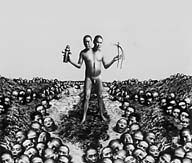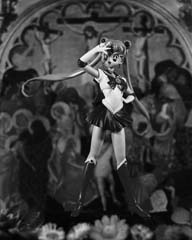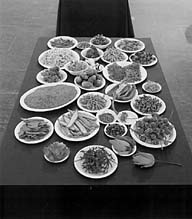L'edicola digitale delle riviste italiane di arte e cultura contemporanea
Flash Art Int. (1999 - 2001) Anno 32 Numero 208 Ottobre 1999
Close to Open
Manray Hsu
Palazzo delle Prigioni, Venice

Franz Ackermann
Wolf-Günter Thiel and Milena Nikolova
n. 216 Jan-Feb 2001
Shangai Biennale
Satoru Nagoya
n. 216 January-February 2001
Aperto Albania
Edi Muka
n. 216 January-February 2001
Cecily Brown and Odili Donald Odita
n. 215 November-December 2000
Cai Guo-Qiang
Evelyne Jouanno
n. 215 November-December 2000
Aperto New York
Grady T. Turner
n. 213 summer 2000



Meant to echo Harald Szeemann's "Aperto over All," the title "Close to Open" was chosen by the curator J.J. Shih to comment on Taiwan's effort to overcome the colonial past and its far-fetching effects. In order to represent the rapid change and cultural diversity resulting from such an "opening" process, he deliberately selected three artists - Hwang Buh-Ching,
Chen Chieh-Jen, and Hung Tung-Lu - from different generations, although they may not have much
difference in age. Each of them occupied an exhibition room in Venice's former jail, the Palazzo delle Prigioni, a venue also used by Taiwan for the last two Biennales.
Entering the main hall, the viewer was greeted by Hwang Buh-Ching's Feast in the Wild, a set of more than ten tables with plates of seeds and herbs on top of flashing colored tablecloths.
The work involves both action and installation. Born in 1948 at an historic seaport in central Taiwan, and having spent eight years in Paris studying art, Hwang has lived in the country for
the past few years and combed the beach for broken furniture, animal bones, drift wood, and other kinds of waste washed clean by seawater. In these found objects he saw the residue and documentation of the dialogue between nature and culture. As his walks became a ritual, he also encountered caltrop seeds which stuck to his pants and accompanied him back to studio and bedroom. The abundance of these spiny objects and their "obsessive" behavior inspired him to make a few works focusing on gender, sexuality, and our relation to nature. The idea of a feast came as he started collecting all sorts of seeds and herbs that opened his eyes to the power of nature.
The audience was invited to "taste" them as guests at old Taiwanese farms after harvest. Hwang also made two huge silhouettes of a female and a male head, and two tall trees, by gluing
thousands of caltrop seeds on the walls.
Working on the shock of images both unspeakable and familiar, Chen Chieh-Jen reproduced computer-manipulated photographs of real historical moments of war, torture, death, punishment, and insanity. For post-photographic human beings, these images have entered the unconscious
through media and cultivation. He incorporated into them images of himself re-performing the moments, as in Genealogy of Self which portrayed a tortured man in ecstasy surrounded by an
excited and curious public, or in A Way Going to the Insane City which documented a funeral procession with actors with broken arms and legs, all performed by himself. The result is the
unavoidable gaze of the viewer who tries to penetrate what "appears" in the picture. Chen referred to the "mirror of evils" in Chinese mythology of the hell. The mirror records all the karmic images of the dead's every single act, thought, desire, and forgotten memory. "What
does the dead one see by looking at this mirror?," he asked. Born in 1960, Chen belongs to the second generation of Taiwanese contemporary artists. In the 1980s when Taiwan went through feverish political upheaval following the economic boom in the 1970s, Chen was involved in a wide
range of activities, making exhibitions and performances on the street, in basements and abandoned apartments, and at the seashore. The solemn atmosphere of the Prigioni is well suited to these photographs which he reproduced in laser prints of about 2.5 x 3 mt.
Next to Chen's was another room which housed Hung Tung-Lu's works in duratrans print on light boxes hung on the walls. Hung (b. 1968) is part of the "new new humans," a Taiwanese equivalent to the "Generation X." He grew up with cartoons, mostly imported from Japan, and the icons of globalized pop culture, which he appropriated and mixed with historical and religious images. In works such as Street Fighter: Chun-Li, Pretty Soldier: Sailor Moon, Lynn Minmay, and Evangelion: Ayanami Rei, he photographed these chic-looking, female cartoon dolls in front of blurry medieval religious paintings.
His cultural logic places the iconized pop images above what used to carry high spiritual and historical weight, such as those of saints and First Gate of the Great Wall. By thus imposing
the new on the old, he ironically canonized the old cultural images. Or, to be more precise, for those who believe in virtual reality and role play more than reality and history, the possibility of redemption and hope seems to lie in elevating the saintly to the level of weightlessness. There is also a downplay of the role of exoticism in his use of images from diverse cultural
backgrounds, which indicates the influence of the rapid global cultural flows at the moment.
Parallel to the official pavilion, art historian Yang Wen-Yi curated an exhibition featuring Huang Yong-Ping's installation VOC (Dutch East India Company) and Yang Mao-Lin's painting series on Dutch colonialism in Taiwan. Sponsored by the Lin & Keng Gallery in Taipei, the exhibition is accompanied by the curator's serious discourse heavily dependent on the now popularized post-colonial theories.
Manray Hsu is a critic and curator based in Taipei.


